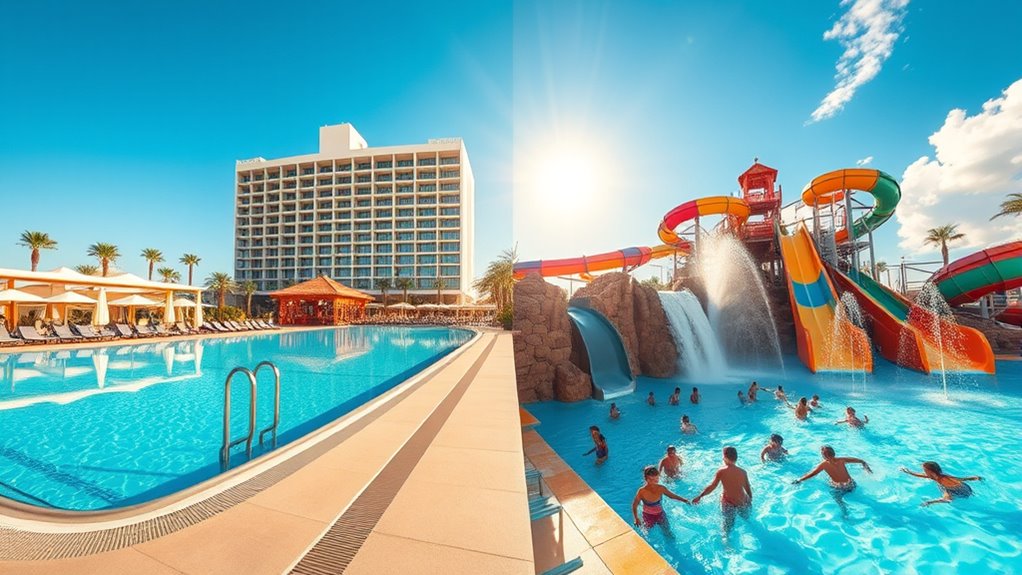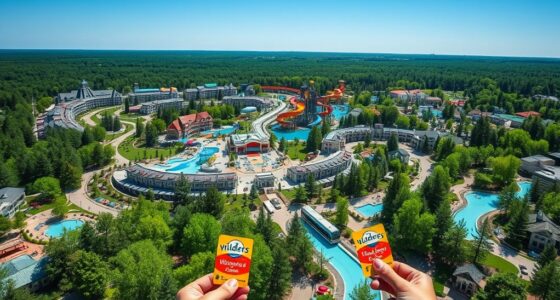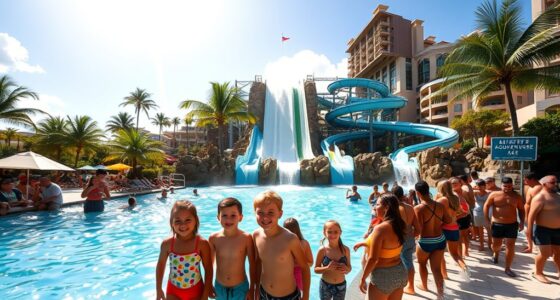Hotel pools are typically smaller, often indoors, and mainly serve hotel guests for relaxation and fitness, with fewer safety concerns. Water parks, on the other hand, are large attractions designed for fun, featuring water slides, wave pools, and various rides, attracting visitors from outside. They require extensive safety protocols and higher operational costs. Understanding these differences can help you compare their impact on guest experience, safety, and environmental management—more details come next.
Key Takeaways
- Hotel pools are typically smaller, often indoors, with controlled environments, while water parks feature large outdoor attractions and numerous slides.
- Water parks are destination venues with higher water volume and variability, whereas hotel pools serve primarily hotel guests for relaxation.
- Accessibility features may differ; hotel pools often have multiple entry options, but water parks focus on specific attractions.
- Water parks usually require extensive safety protocols, lifeguard staffing, and specialized maintenance due to larger scale and higher risks.
- Operational costs, staffing, and maintenance are generally higher for water parks compared to hotel pools, which are more integrated into existing hotel facilities.
Revenue and Business Impact
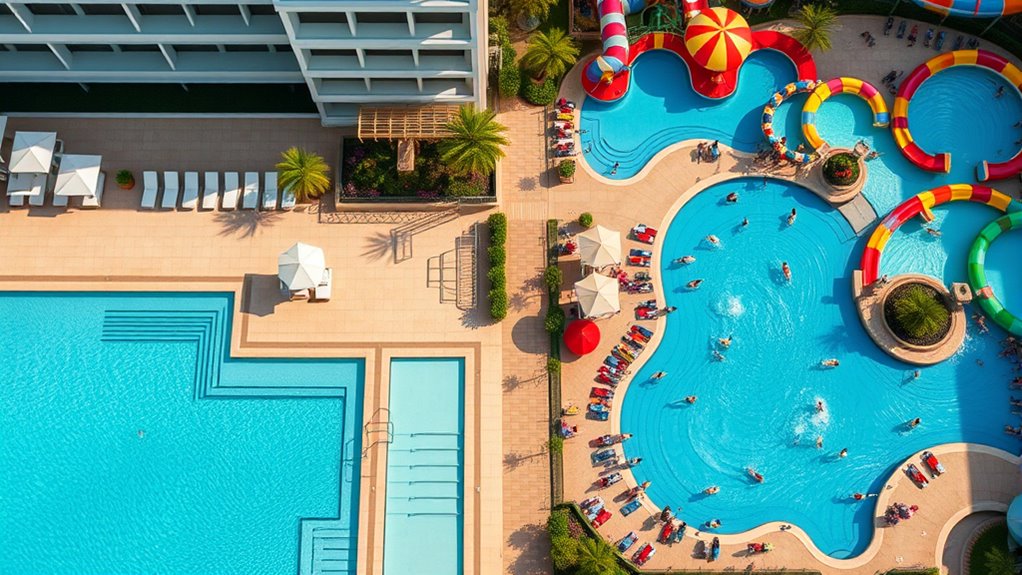
Hotels with water parks considerably boost their revenue and competitive position by attracting more guests and encouraging longer stays. You’ll see over half your revenue come from ticket sales, with additional income from food, merchandise, and rentals. By offering a water park, you can charge higher room rates and improve occupancy, even during slower seasons. Allowing non-hotel guests to access the water park during off-peak times can further increase revenue. Your hotel benefits from higher RevPAR and gains a competitive edge, especially to families. Water parks also help differentiate your brand and extend guest stays, increasing spending on F&B and other amenities. These attractions make your property more attractive, boosting market performance and creating a memorable experience that keeps guests coming back. Indoor waterparks help mitigate seasonality and weather risks, ensuring steady revenue streams throughout the year. Additionally, incorporating angel number insights can enhance your understanding of customer preferences and improve marketing strategies.
Water Consumption and Environmental Considerations
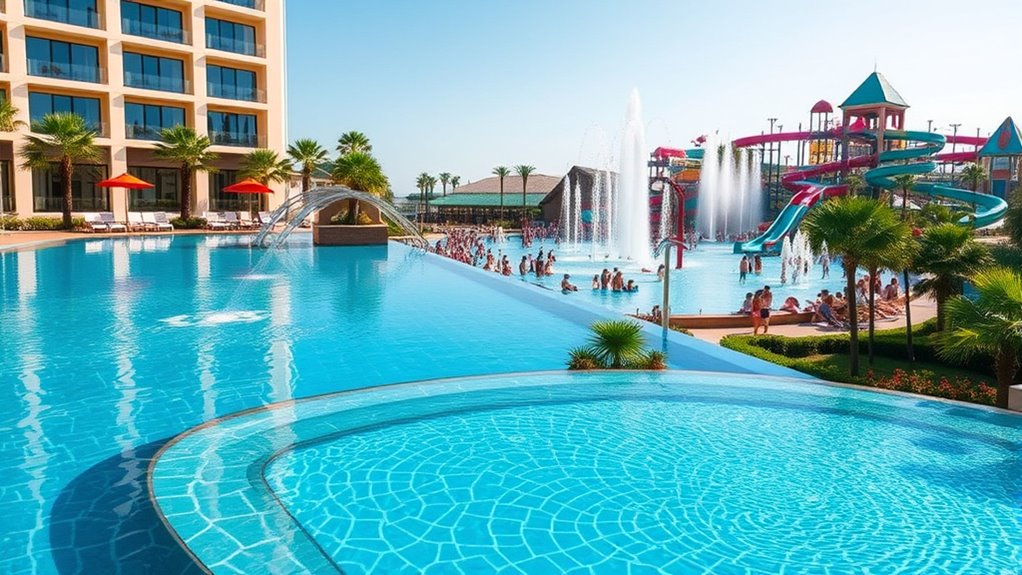
You need to contemplate how water use varies between hotels and water parks, especially since pools can account for a significant chunk of their consumption. Larger pools in water parks typically use more water, but evaporation losses and maintenance methods also impact overall efficiency. Additionally, filtration technology plays a role in minimizing water waste through effective water recycling and treatment. Reducing water waste and adopting sustainable practices are essential to minimizing environmental impacts in both settings. Water scarcity affects over 40% of the global population, making it crucial for these venues to implement responsible water management strategies.
Water Usage Variability
Water usage variability between hotel pools and water parks stems from differences in size, environment, and operational practices. Larger pools in water parks lose more water annually through evaporation, splash-out, and cleaning, especially with outdoor attractions exposed to wind and sun. Hotel pools, being smaller and often indoors, experience less surface area and more controlled conditions, reducing water loss. Evaporation rates scale with surface area, making water parks more prone to fluctuations throughout the year, depending on climate and weather. Frequent refilling is necessary for both, but water parks require more extensive management due to their scale and complexity. While hotels focus on balancing guest experience with efficiency, water parks face the challenge of handling larger volumes and higher water turnover, resulting in greater variability in water usage. Additionally, implementing water-efficient technologies and management practices can help mitigate these variabilities and promote sustainability across both types of facilities through water-saving innovations. Incorporating sustainable practices can significantly reduce overall water consumption and environmental impact.
Environmental Impact Factors
Environmental impact factors of pools, including water consumption and broader ecological considerations, play a crucial role in evaluating their sustainability. Hotel pools often use large amounts of water, which can strain local resources, especially in regions facing water scarcity. To address this, many hotels adopt conservation measures like smart filtration systems and natural biofilters that minimize waste and reduce chemical use. Energy consumption is another concern; traditional heating methods are increasingly replaced by renewable options such as solar or geothermal systems, lowering greenhouse gas emissions. Additionally, eco-friendly materials and waste reduction practices help lessen the environmental footprint. Implementing sustainable design principles in pool construction and maintenance further contributes to reducing environmental impact. By understanding these factors, you can better assess how hotel pools contribute to environmental challenges and the efforts underway to promote more sustainable hospitality practices.
Ownership Models and Market Trends
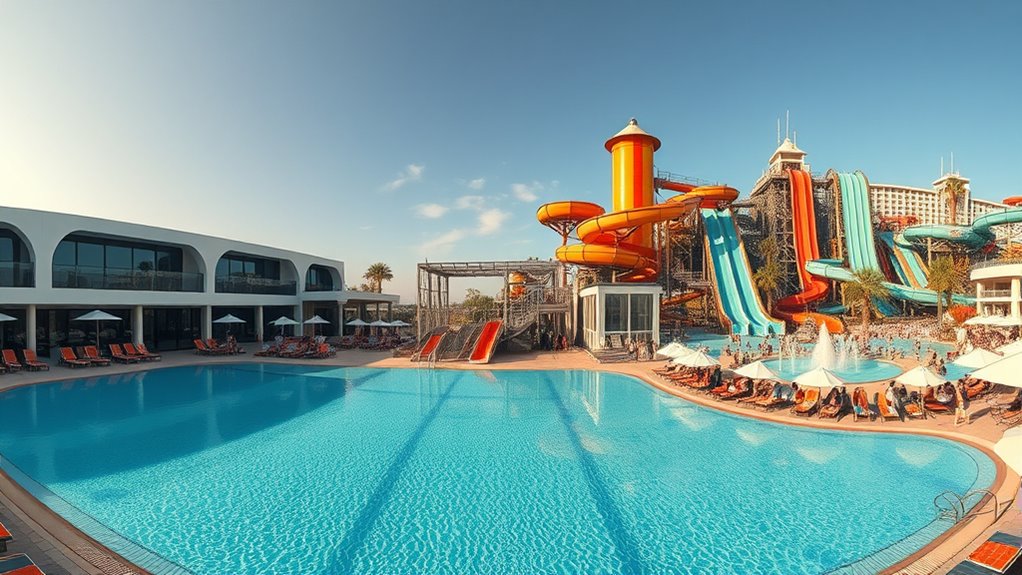
Ownership models for hotel pools and water parks reflect distinct approaches driven by their scale and business objectives. Hotel pools are owned and operated mainly by hotel companies, often through management contracts, serving as amenities to boost guest experience and property value. Water parks, on the other hand, usually follow larger, capital-intensive ownership structures—owned by entertainment corporations, municipalities, or public-private partnerships—requiring separate revenue streams and dedicated staff. Additionally, the cost structure of each model influences their investment and operational strategies.
Safety and Health Risks
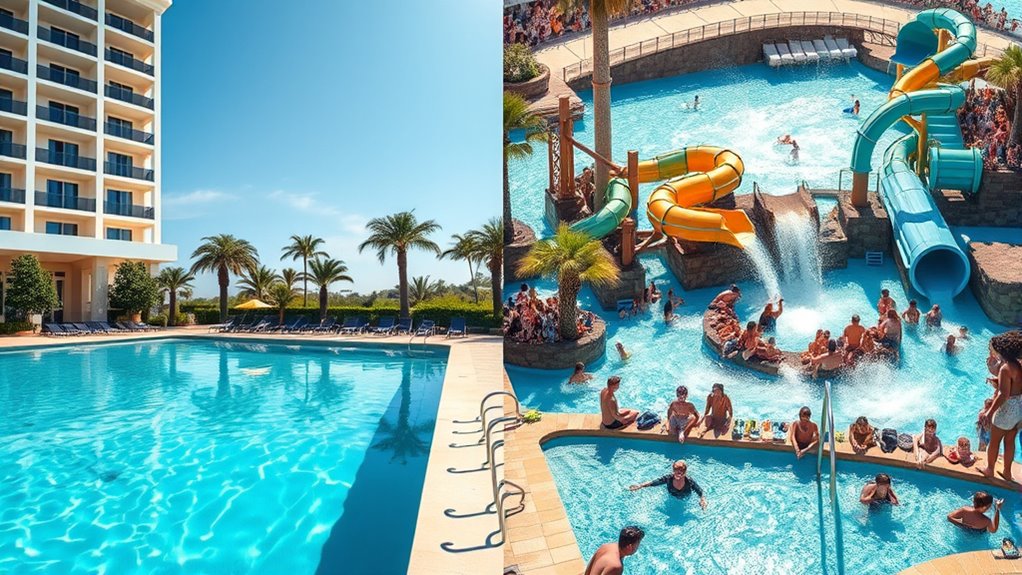
Both hotel pools and water parks pose significant safety and health risks that you should consider before swimming. Drowning incidents can happen easily if supervision is inadequate, especially in crowded or unfamiliar environments. Additionally, waterborne pathogens and emergency response preparedness are vital factors that can impact your safety during your visit. Overcrowding can also hinder effective supervision and increase the likelihood of accidents. As technological advancements in Automation in Business continue, safety protocols and monitoring systems are being enhanced to better protect swimmers and visitors.
Drowning Incidents Risk
Drowning incidents at hotel pools and water parks pose serious safety and health risks, especially for vulnerable populations. Young children, particularly ages 1–3, are the highest risk, with over half of drownings linked to hotel pools. Boys under 15 are twice as likely to drown, and most incidents happen without supervision. Adults aged 45–54 also face significant danger. Drownings often occur during peak times like spring afternoons and Sundays. Proper supervision and safety measures are essential to prevent these tragedies.
Waterborne Pathogens Threat
Waterborne pathogens like *Cryptosporidium*, *Legionella*, and *Pseudomonas* pose significant health risks in hotel pools and water parks. *Cryptosporidium* causes most outbreaks and illnesses because it resists standard chlorine treatments, spreading through contaminated water, especially when swimmers are sick or have diarrhea. *Legionella* can lead to severe respiratory infections and has caused most deaths in waterborne outbreaks. *Pseudomonas* results in skin rashes and swimmer’s ear, often thriving in poorly maintained water. Water parks, with their complex systems and large crowds, heighten these risks, while hotel pools often see outbreaks during summer peaks. Proper maintenance, public awareness, and hygiene practices are crucial to reduce these threats, but they can’t eliminate the risks entirely. Additionally, proper water management is essential for minimizing pathogen growth and ensuring swimmer safety.
Emergency Response Preparedness
Effective emergency response preparedness is crucial to guarantee safety and minimize risks during incidents at pools and water parks. You need extensive plans that include procedures for medical emergencies and evacuations, tailored to each setting. Staff training in first aid and CPR ensures quick, effective responses. Reliable communication systems, like pool phones, allow instant coordination. Regular emergency drills help staff stay prepared, reducing response times. Well-maintained incident reports support continuous improvement. Safety equipment such as lifeguards, rescue devices, and alarms must be accessible and functional. Monitoring pool conditions and enforcing safety rules prevent accidents. Proper handling of chemicals and weather emergency protocols protect patrons from health hazards. Ensuring regulatory compliance and educating guests about safety procedures further strengthen emergency preparedness, safeguarding everyone involved. Incorporating appropriate equipment like pressure gauges and safety tips can further enhance response efficiency and safety measures.
Guest Experience and Amenities
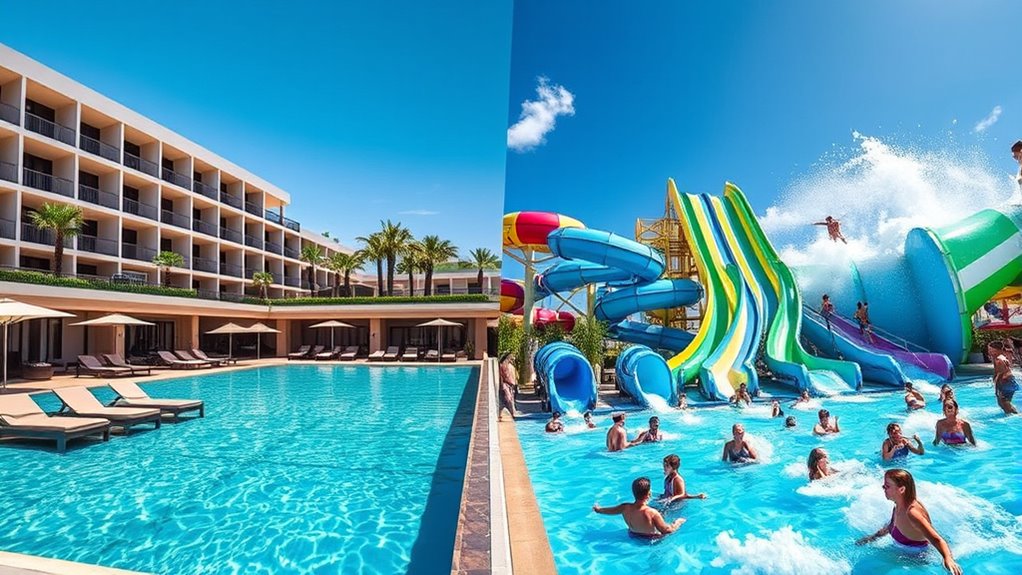
Hotels with water parks considerably elevate the guest experience by offering a wide range of amenities and interactive activities that go beyond traditional pools. You get access to exciting features like water slides, wave pools, and splash pads, creating fun for all ages. High-quality towels, locker rentals, and food services add convenience, making your visit seamless. Technology, such as RFID wristbands, streamlines entry and payments, enhancing your overall experience. These amenities foster memorable moments, especially for families, who appreciate activities tailored to children and adults alike. By providing diverse attractions and services, water parks not only boost guest satisfaction but also encourage longer stays. This combination of entertainment and comfort sets water parks apart, giving you a richer, more engaging hotel experience. In addition, water parks often incorporate sustainable practices, such as water recycling and solar energy, to minimize environmental impact while maximizing guest enjoyment. Implementing sustainable practices not only benefits the environment but also enhances the reputation of the facility among eco-conscious travelers.
Accessibility and Convenience
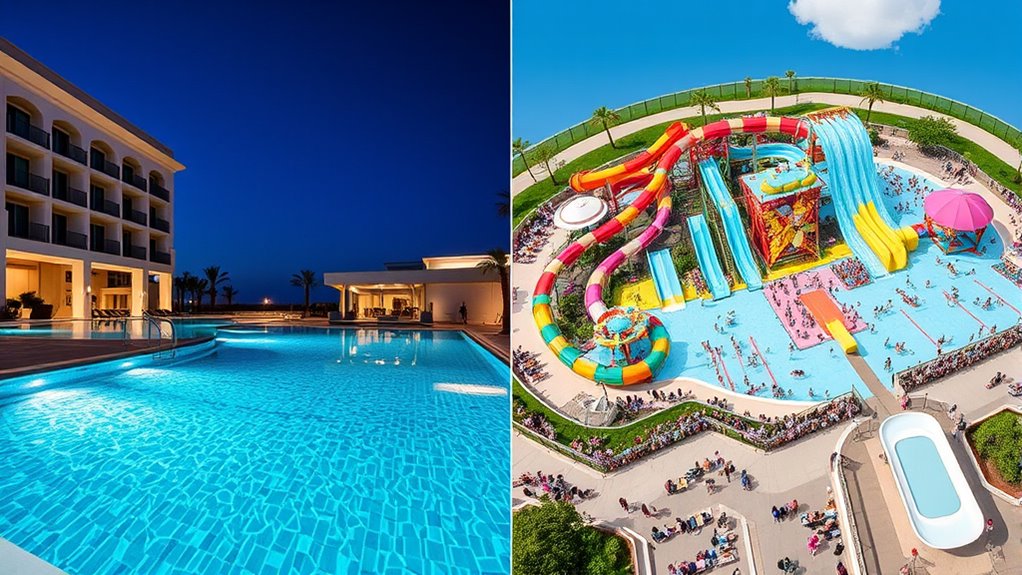
Accessibility and convenience play vital roles in ensuring everyone can enjoy the water features, especially for guests with disabilities. Hotel pools often have multiple entry options like sloped ramps, pool lifts, and transfer walls, but not all facilities meet ADA standards. Accessible design is crucial for inclusivity, yet some properties may lack comprehensive features. Water parks typically install at least one accessible entry per major attraction, such as wave pools or lazy rivers, yet may lack comprehensive access throughout the park. Proximity also matters: hotel pools near guest accommodations promote easy, frequent use, while water parks, often destination-based, limit accessibility outside their grounds. Transportation options vary, with hotels providing shuttle vans—though not always accessible—while water parks rely on resort transport or nearby public transit. The table below summarizes key accessibility features:
| Feature | Hotels | Water Parks | Common Accessibility Challenges |
|---|---|---|---|
| Entry Options | Sloped entries, lifts | At least one accessible entry | Inconsistent feature availability |
| Proximity | Close to accommodations | Usually destination-based | Limited outside park boundaries |
| Transportation | ADA shuttles, public transit | Resort shuttles, transit | Insufficient accessible transport |
| Design Ease of Access | Fewer entry points | Multiple attractions | Varying compliance levels |
Additionally, some hotels have started implementing ADA-compliant lifts and ramps to improve access, but ongoing maintenance and staff training are essential to ensure these features remain functional and effective.
Operational Costs and Management
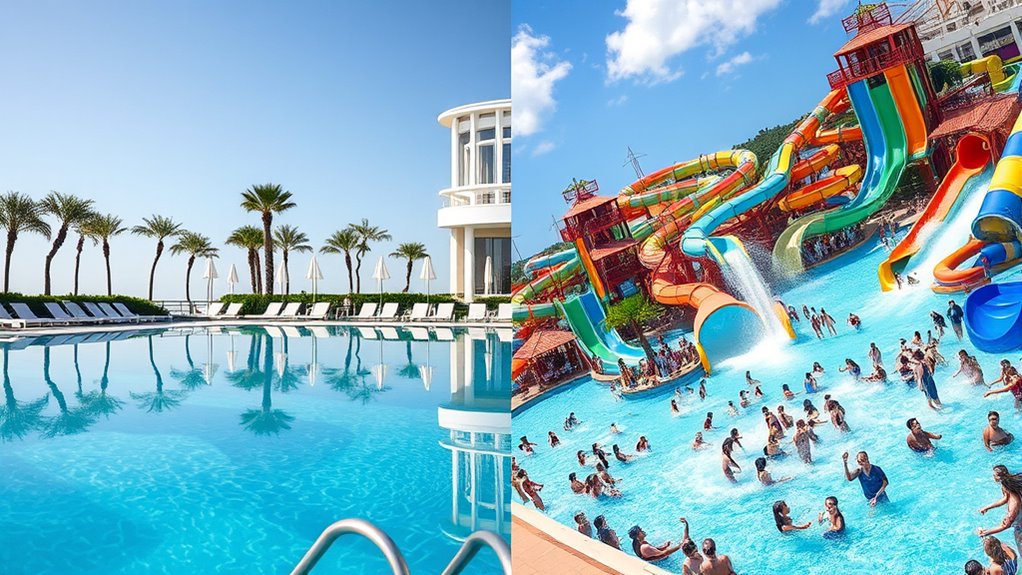
Managing the operational costs of a waterpark involves balancing significant expenses with potential revenue streams. Construction costs can range from $250 to $500 per square foot, while departmental expenses, like staffing and supplies, typically cost $15.31 to $25.51 per square foot. Energy expenses, including heating and pumps, add another $13.00 to $21.39 per square foot. To stay efficient, you should create a dedicated waterpark team led by an aquatics director, ensuring proper staffing, maintenance, and safety protocols. Regular upkeep, chemical management, and exhaustive insurance are essential to minimize risks. Although costs are higher than public pools, waterparks can generate millions annually and recover investments within a few years. Market research and feasibility studies are crucial for estimating guest numbers and revenue potential. Effective management helps maximize revenue and control expenses, ensuring long-term profitability. Additionally, leveraging precious metals IRA strategies can help fund future expansions or upgrades by diversifying investment portfolios.
Frequently Asked Questions
How Do Water Quality Standards Differ Between Hotel Pools and Water Parks?
Water quality standards differ mainly in testing frequency and complexity; water parks require more frequent and diverse testing due to their larger size and multiple attractions. You need to monitor disinfectant levels, pH, turbidity, and combined chlorine more rigorously in water parks. Hotel pools have simpler, daily testing protocols focused on maintaining safe chlorine and pH levels, but both venues must keep detailed records and follow strict disinfection practices.
What Are the Typical Staffing Requirements for Operating Hotel Pools Versus Water Parks?
Imagine you’re managing a hotel pool and a water park. For your hotel pool, you need a certified pool operator and CPR-trained staff, but lifeguards aren’t always required unless it’s large or deep. At the water park, you require continuous lifeguard coverage with higher staffing ratios, like one guard per 15-25 swimmers, plus specialized staff for slides and rides. The water park’s staffing demands are notably higher to guarantee safety.
How Do Seasonal Operations Impact Revenue for Hotel Pools and Water Parks?
You’ll see seasonal operations substantially impact revenue for both hotel pools and water parks. During peak months, you generate higher income from guest usage, food, and retail sales. Off-season, revenue drops sharply as pools close or see limited activity, especially for water parks. Hotels can offset this with year-round amenities like heated pools, but water parks rely heavily on summer sales, making seasonal planning essential for maximizing revenue.
What Are the Specific Environmental Regulations Affecting Water Usage in Water Parks?
Imagine a water park in California that must maintain chlorine levels between 1.0-3.0 ppm. You’re responsible for monitoring water quality daily, ensuring microbial counts stay below 18 organisms per 100 mL, and turbidity remains under 3 NTU. These regulations mandate continuous chlorination, filtration standards, and frequent testing to protect visitors and the environment. Compliance requires diligent record-keeping, advanced water treatment, and reuse systems to minimize environmental impact.
How Do Guest Safety Protocols Vary Between Hotel Pools and Water Parks?
You’ll find safety protocols differ mainly in supervision and complexity. At hotel pools, you might rely on signage and self-monitoring, with fewer staff oversight. Water parks, however, have more staff, detailed safety briefings, and designated zones for different age groups. They enforce stricter rules, provide thorough emergency plans, and make sure staff are specially trained. Both prioritize safety, but water parks handle higher risks with more rigorous protocols.
Conclusion
Choosing between hotel pools and water parks depends on your priorities. Hotel pools often generate steady revenue with lower costs, while water parks attract larger crowds, boosting overall business. Did you know water parks can see up to 80% more visitors during peak season? Consider safety, environmental impact, and guest experience when deciding. Whatever you opt for, balancing operational costs with guest satisfaction ensures your water attraction remains a splash hit.

